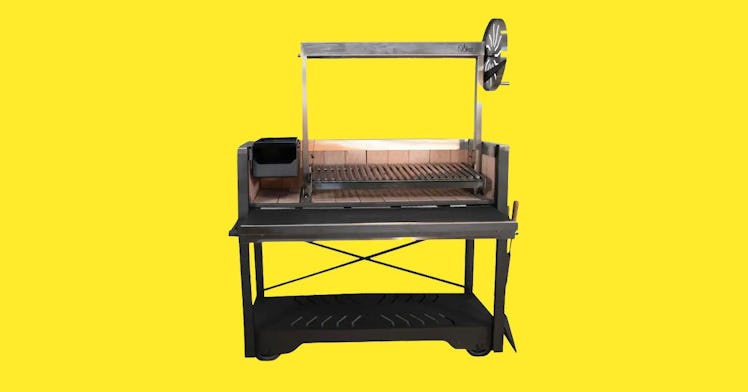A Parrilla Makes Even Cool-Weather Grilling Worth It
Celebrate the cookout by putting on a show with an Argentinean-style grill.

Despite the primitive nature of cooking over fire, grilling has become notably advanced. Modern cookers can come fitted with everything from supercharged infrared heating elements to temperature-controlling fans to Wi-Fi connectivity for real-time data through your phone. All in the name of keeping you less involved. But if you enjoy cooking outside — and according to a 2020 report from the Hearth, Patio & Barbecue Association, 75% of grill owners use their cookers during the winter — the food and experience of using the Puma is worth shoveling a path through the snow for. It’s the most fun I’ve had using a charcoal grill and without question is the centerpiece of the backyard when warmer weather comes around.
I used the Nuke’s Puma for a few weeks this summer and found it to be a very hands-on way to cook. From building the fire to controlling the heat, it makes grilling a unique experience. The distinguishing feature of this Argentinean-style grill (parrilla) is the wheel that you turn to raise or lower the grate over the coals using cables. You can drop it down to about 4 inches above the heat to sear burgers or raise it to about 20 inches to accommodate a taller fire or act as a warming shelf. I grilled whole chickens, corn on the cob, squash, burgers, and sausage on it, often adjusting the wheel to ensure things didn’t burn or take too long to cook. Yes, playing with the wheel and listening to the metal gears click as the grate moves is addicting.
The V-shaped grates offer 474 square inches of cooking surface — about what a three-burner gas grill would have — through three lightweight, removable sections. Instead of the round stainless steel bars most gas and charcoal grills have, which encourages fat to drip off the meat, igniting on the coals, the Puma’s grates catch most of the fat, diverting it to a drip trough in front. As a result, there are fewer flare-ups and you’re not forced to play move-the-meat-out-of-the-inferno while cooking.
Despite the association with a fast jungle cat, the Puma is not quick to get going, but it is pretty easy to use. Ignite wood logs or charcoal in the fire basket on the left. Then, as the fuel burns, it gets hotter and smaller, falling through the basket onto the brick floor of the firebox. With the included poker, you slide the coals under the grate to start cooking. Then you add more logs directly onto the coals or, alternatively, you can start a charcoal fire directly on the firebox floor. If you’re used to cooking with a standard kettle grill, get ready to spend more time getting the Puma loaded up to cook — the firebox floor is a lot of surface to cover with blistering hot coals, unless you’re only cooking over half of the grate for one or two people.
While cooking, you can leave the wide front door open to adjust the coals or close it to retain heat, then dial in the height of the grate as needed. For most of our bigger proteins we kept it closer to the top for slower, more even heat. You can also top the firebox with a rectangular steel pan (also included) to cook smaller vegetables or sear things you’d normally use a skillet for, like fish or shrimp.
Everything we cooked on it, from proteins to fruits and veggies, came off the heat with a pleasing woodfire scent. The grill itself is a visual show-stopper and anyone you’re cooking for will be drawn to it. Hands will want to touch the wheel. Like a kettle or gas grill, it’s possible to build a two-level fire to have even more control over the temperature. The Puma could cook all day: start a fire in the morning and grab a pan for scrambled eggs and bacon for breakfast, then move right into grilled sandwiches for lunch and heartier food for dinner. You can build some pretty epic fires in here that can verge on the crackle, pop, and glow of a fire pit. S’mores are pretty easy to pull off, too.
Shipping can be an issue. Some of the bricks broke in transit, although Nuke replaces those at no charge. You’ll also have to keep after the maintenance of the grill. A lot of the steel around the firebox is stainless, but the grill body and the car below are painted steel, which can rust. Unlike a kettle grill that has an ash catcher, you’ll have to remove the ashes after each cook with the included tools, which can be more time-consuming. You might also want to consider switching to firewood instead of coals, which is part of the fun.
When it comes to putting the grill together, it’s both easy and very difficult. Easy in the sense that it’s a handful of nuts and bolts you have to tighten with an included wrench. And hard because the Puma’s firebox arrives laden with all the bricks, so it weighs about 300 pounds. You will need two or three friends to help lift the firebox onto the base. Pro tip: Take the bricks out of the firebox first, which will help reduce the weight. The grill cart is hefty and you can store logs or charcoal underneath (the Puma comes with a cover that extends all the way down to the base of the cart) but the wheels on the cart do not pivot, so moving it around takes more effort than it should.
Every product on Fatherly is independently selected by our editors, writers, and experts. If you click a link on our site and buy something, we may earn an affiliate commission.